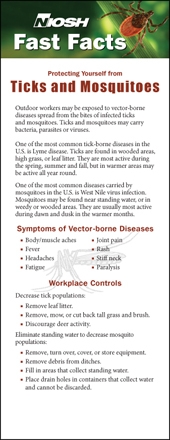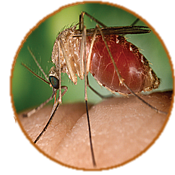NIOSH Fast Facts: Protecting Yourself from Ticks and Mosquitoes
April 2010
DHHS (NIOSH) Publication Number 2010-119

Outdoor workers may be exposed to vector-borne diseases spread from the bites of infected ticks and mosquitoes. Ticks and mosquitoes may carry bacteria, parasites or viruses.
One of the most common tick-borne diseases in the U.S. is Lyme disease. Ticks are found in wooded areas, high grass, or leaf litter. They are most active during the spring, summer and fall, but in warmer areas may be active all year round.
One of the most common diseases carried by mosquitoes in the U.S. is West Nile virus infection. Mosquitoes may be found near standing water, or in weedy or wooded areas. They are usually most active during dawn and dusk in the warmer months.
Symptoms of Vector-borne Diseases
- Body/muscle aches
- Fever
- Headaches
- Fatigue
- Joint pain
- Rash
- Stiff neck
- Paralysis
Workplace Controls
Decrease tick populations:
- Remove leaf litter.
- Remove, mow, or cut back tall grass and brush.
- Discourage deer activity.
Eliminate standing water to decrease mosquito populations:
- Remove, turn over, cover, or store equipment.
- Remove debris from ditches.
- Fill in areas that collect standing water.
- Place drain holes in containers that collect water and cannot be discarded.

Mosquitoes and ticks may carry bacteria, parasites or viruses.
Image courtesy of U.S. Department of Agriculture
Protect Yourself
- Wear a hat and light-colored clothing (so ticks can be easily spotted), including long-sleeved shirts and long pants tucked into boots or socks.
- Use insect repellents.
- Use repellents containing 20–50% DEET on exposed skin and clothing.
- Reapply repellents as needed. (Always follow products labels).
- Use insecticides such as permethrin for greater protection.
- Permethrin can be used on clothing, but not on skin.
- One application to pants, socks, and shoes may be effective through several washings.
- Check skin and clothing for ticks daily. Check hair, underarms, and groin.
- Immediately remove ticks using fine-tipped tweezers.
- Grasp the tick firmly, as close to your skin as possible.
- Pull the tick’s body away from your skin with a steady motion.
- Clean the area with soap and water.
- Wash and dry work clothes using the “hot” settings to kill any ticks present.
- If you develop symptoms of a vector-borne disease, seek medical attention promptly. Tell your doctor that you work outdoors and report any ticks or mosquito bites.
NIOSH Fast Facts: Protecting Yourself from Ticks and Mosquitoes [PDF 1.0MB]
